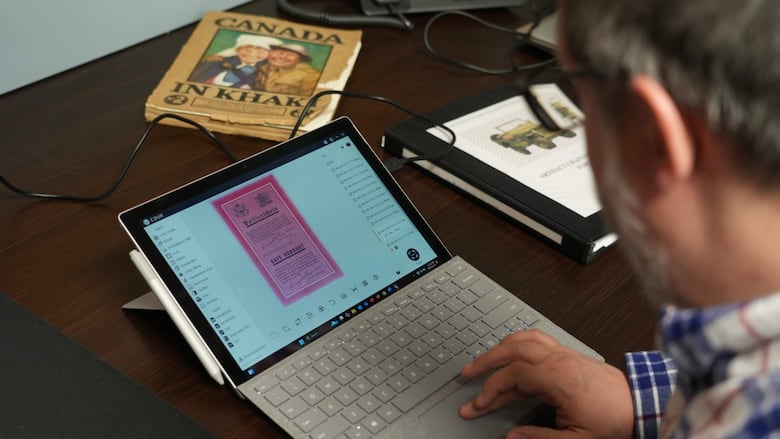One artifact at a time, this museum in northern Alberta is preserving Canada's military history
Wood Buffalo Military Museum in Fort McMurray cares for thousands of fragile items

Sitting at the desk in the corner of a meeting room of the Wood Buffalo Military Museum Centre in Fort McMurray, Alta., collections specialist Geoffrey Jones gingerly places a leaflet with text in German and English under the scanner.
The pinkish-purple propaganda leaflet is a letter of safe conduct for German soldiers wanting to surrender to the Allied forces during the Second World War.
The English text reads: "The German soldier who carries this safe conduct is using it as a sign of his genuine wish to give himself up. He is to be disarmed, looked after, to receive food and medical attention as required, and to be removed from the danger zone as soon as possible."
The leaflet bears a facsimile signature of Dwight Eisenhower, Supreme Commander of the Allied Expeditionary Force.

This leaflet is one of thousands of artifacts in the museum's collection. Jones can't produce an exact figure — "We need to get that number pinned down," he says. Cataloguing the collection is one of the museum's top priorities.
The museum possesses a large variety of artifacts — from a Chieftain battle tank parked in front of the museum, to documents and books, such as the leaflet for the German soldiers.
The museum is working to preserve its artifacts for the future. Different types of artifacts have different conservation requirements.
Weapons, for example, can last quite a long time if they are kept away from the sun and water, so that metal and wood don't expand and contract at different rates, Jones said. In the museum, deactivated firearms are kept in a special room.

Saving old books and documents
Documents and books can be considerably more fragile, especially if they haven't been properly preserved before arriving at the museum. Touching them directly should be limited, or avoided completely. Oils in human skin can cause documentation to age and break down.
When Jones handles old documents, he wears white cloth gloves. But that creates challenges as well.
"The trade-off being, of course, that when you do that, you are losing some of your dexterity," he said.
"You always need to be careful. If you're wearing gloves, you always need to make sure you're extra on-point with your hand movements to make sure you're not being too careless and letting things slip."
Scanning and digitizing its documentary collection is one of the projects currently in progress at the museum, though it is at an early stage, Jones said.

Digitizing books and documents and making them available in PDF format will make them more accessible to the general public and promote greater and better understanding of Canada's past, the museum believes.
One of the books that Jones is working on digitizing is called Canada in Khaki. It was published in 1910.
"It's a really interesting document to kind of see the zeitgeist leading up to World War I," said Kevin Rodgers, the museum's curator.
"It's kind of a celebration of imperialism."
The book is fragile. The glue in its binding is barely holding on.
Digitizing it is important, Jones said. Without having it in digital format, people who want to familiarize themselves with its contents would be risking further damage by handling it.
Preserving while displaying
The museum has to strike a balance between following the best artifact preservation practices and still allowing the public to see them.
The museum displays an RCMP buffalo coat that museum founder and president Dale Bendfeld found in Fort Chipewyan, Alta.
"It should actually be in a freezer," Bendfeld said. "But no one can see it in the freezer."
"One of the long-term goals we have is to get the right stuff, to not only digitize things, but also to save these types of artifacts for future generations, because no one will ever see these types of jackets again."
The museum shares premises with the Royal Canadian Legion at 9317 Huggard St. in Fort McMurray. It is open to the public and there is no admission fee.

